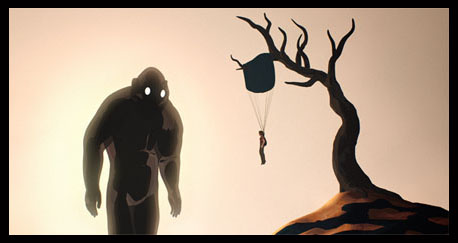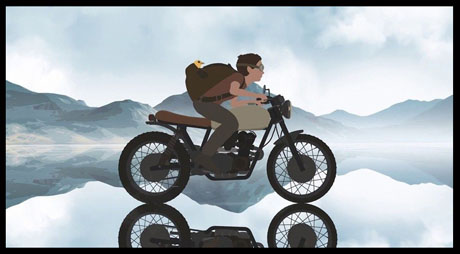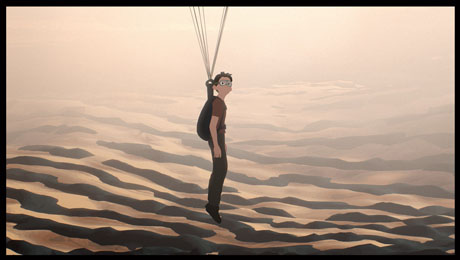
Gints Zilbalodis made an animated feature by himself. Away, now playing in select theaters, is one of this year’s Oscar qualified animated films. It’s about a boy who ends-up on an island and has to try to get back home. Zilbalodis discusses the efforts it took to bring Away to life.
Jackson Murphy: It is nothing short of remarkable – the fact that you made this movie all by yourself. I would love to know, first of all, the initial inspiration for this.
Gints Zilbalodis: I wanted to make a feature, but I know that it is very difficult. To make things easy, I decided to set the story around things that are easy to animate. So that’s why he’s riding a motorcycle, and that’s why I don’t have many characters – and it’s set on this desert island. So the story grew out of limitations that I had. I also knew that I didn’t really have any other choice but to make it myself. It’s a really small budget film, so I thought it would also be a good way to learn filmmaking by actually trying everything myself – to do the music, to do the animation and everything.
Gints Zilbalodis: On my next film, I’m actually working with a team. I think I can now speak their language better, because I’ve actually done all the things they’re doing. It was also like a film school experience for me to do everything myself.
JM: Is that Flow that you’re working on now?
GZ: Yeah. My next film Flow is an adaptation of a short film I made a few years ago about this cat who’s afraid of water. I’m just getting started on that one, and it’s my next feature. It’s also without dialogue or human characters this time. It’s gonna have a bigger budget this time. I’m planning on working with a small team of animators and other people. I’ve been telling people that Away is about me making this film alone – the story is about this boy alone on an island, so it’s just like me making this film. And my next film Flow is gonna be about a group of characters – different animals and they’re trying to work together and sometimes fighting and sometimes supporting each other. It’s gonna be about me making this next film with a team.
JM: I love the parallels. When it comes to Away, when you were telling people, “I’m gonna make this animated film all by myself”… how many people thought you were crazy?
GZ: (laughs) I didn’t really ask for permission, so I don’t know how many. But I did think it would be difficult to fund it because I didn’t really have any experience. No one’s really done something like this – making a feature on their own. So when I was looking for funding, I decided to split it up in four chapters. So it was actually funded as four short films because I thought that would make it less risky for the financiers to trust me. It was also easier for me to make the transition from shorts to a feature because the amount of work when making a feature is so great that I think I would just be too overwhelmed if I jumped directly into making a traditional feature. By splitting it up into chapters, it was easier for me to manage the story. I was trying to structure each chapter to kind of stand on its own. Each chapter has its own beginning, middle and end. People were very trusting in me to do this – my family, my friends.
I hope that this becomes more common – that people are making their own films. Now technology is allowing that – to make a film on your laptop. I hope that more people do this, and then we can see more experimentation and the technique and more personal stories being told. I think it’s gonna happen, especially in 3D animation. If I would do this in stop-motion, then it would be really difficult – to set up the studio and all the lights. That’s very expensive. In 3D, I can take one character and copy it many times. I have this black cat, which is just basically one model of a cat that I copied many times, and I could save a lot of time that way.

JM: I think you’re going to open the door for a lot of people who will see Away and then want to try this on their own. As I was watching the movie, I was wondering if the shape-shifting giant is Death, or is it something even greater than Death?
GZ: It’s interesting. I’ve heard many different interpretations about that giant. Some people say that for them it’s death. Some people think that it’s depression or anxiety. I didn’t want the giant to be evil. I wanted it to be very objective. It doesn’t really have an opinion – it’s like a force of nature. Now that the film’s out there, I’m interested in what people think about the meaning of it. For me personally, when I made this film on my own, I had all this pressure to finish it. There’s always something: doubts, anxiety and negative emotions that follow me when I tried to reach this goal of finishing the film.
JM: What really impressed me is the movement within every shot. I love how the camera zooms in at various points and swirls around. How did you do those movements?
GZ: I didn’t really have a traditional screenplay for the film, and I didn’t have storyboards. All the movement was very improvised directly in the 3D software. So I would begin my making the environment and then add characters in the environment – just try experimenting and see where they go. And then I can take the camera and try different angles. I can take the same animation and shoot it from a wide angle – and a close-up or these crazy long takes. It was all very fluidly improvised, without a proper storyboard.
Especially if you take one element away, like the dialogue, the other elements of filmmaking have to be more present and have a bigger role in telling the story. The camera becomes a very important tool that is telling what’s usually told through dialogue in films. Especially in 3D animation, I think it’s the only way that I can actually pull some of these camera moves off. I have animals and water and many unpredictable things that you couldn’t do in live-action. And in 2D, you can only do very limited camera moves. So I think 3D animation is really great for experimenting with the camera.

JM: And some of the shots, to me, felt a little bit like they could be used in a live-action movie, like a Mission: Impossible. Would you be interested in tackling some live-action films?
GZ: Sure, yeah. I’ve done some live-action already – very primitive, amateur films. But I think I need to gain more experience. I’m gonna do one more animated film at least (Flow). But maybe after that I’ll try to do some live-action because I’m influenced by mostly live-action filmmakers, rather than animators. The way they use the camera, and the way they think about the space – rather than just the graphic image. The camera is moving quite a lot, so I tried to think in terms of space rather than just flat images.
JM: How did you get the sound work right, especially for the motorcycle?
GZ: It’s very simple. Most of the sounds are from libraries available online. I recorded some sounds that I couldn’t find. For example, I couldn’t find the flock of birds flying. I just took some pillows and was waving them around. It’s kind of funny. I recorded myself breathing. Sound is also very minimalistic. I tried to have quiet moments in the film that contrast with fast-paced moments. Usually animation is very loud and very active, like the big studio films. So I tried to have these quiet moments, too.
JM: What surprised you the most, honestly, in doing something like this?
GZ: It was quite smooth, the whole process. There weren’t really any big setbacks. Actually, it was just my own mistake that I lost some files of the first chapter. I had to do the first chapter pretty much from scratch the second time. I learned a lesson to make more back-ups. It surprised me that it’s embraced, actually, this film – worldwide in festivals – because I was just making it for myself. The bigger budget films need to cater to an audience, and they need to make their budgets. But I didn’t really have to think about it. I was just making it for myself. It’s this personal story about me trying to reach this goal. So I didn’t really know how it would be received. I’ve been very lucky to go to all these festivals. And maybe it will now be easier to make my next film.
JM: How were you able to submit this for the Academy Awards?
GZ: I didn’t do that myself. I have a distributor in the U.S. that’s releasing it now. They did all that. Luckily I don’t need to worry about that. I have so much work to do with this film and now my next film. It’s really great that I don’t have to worry about all the submissions anymore.
JM: Were you surprised, though, that it ended-up being one of the qualified movies for the Best Animated Feature Oscar?
GZ: I was pretty surprised. It’s very crowded this year, too. There are so many big films and also so much great independent animation. It’s very competitive. But it’s really great to be in the same conversation with these big Disney and Pixar films. Their budgets are so much bigger than mine. But just to be in the same consideration is great. It just shows that, I guess, the budget isn’t everything. Ideas are more important. I hope it’s gonna become more common – these more independent films being made.

- INTERVIEW: Jeff Fowler On “Knuckles” And “Sonic 3” - April 22, 2024
- INTERVIEW: “Inside Out 2” Director And Producer On Pixar Sequel - April 16, 2024
- INTERVIEW: “Puffin Rock And The New Friends” And 25 Years Of Cartoon Saloon - April 10, 2024


 November 30th, 2019
November 30th, 2019  Jackson Murphy
Jackson Murphy  Posted in
Posted in  Tags:
Tags: 






